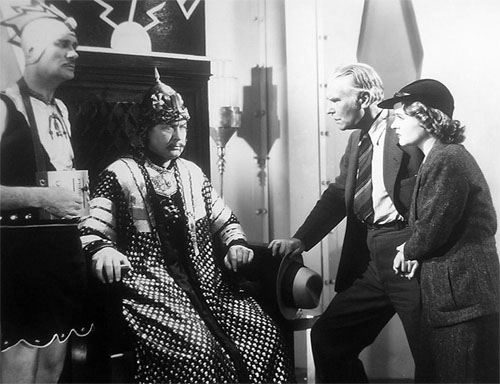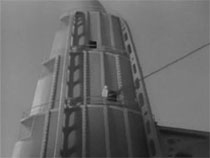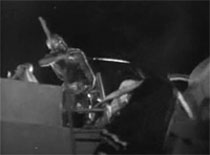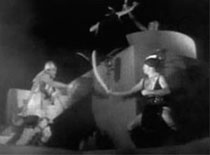
Republic, 12 Chapters, 1936. Starring Ray “Crash” Corrigan, Lee Van Atta, C. Montague Shaw, Monte Blue, Lois Wilde, John Merton, William Farnum.
Undersea Kingdom begins with a protracted introduction to our hero, US Navy lieutenant “Crash” Corrigan (Ray Corrigan), in a series of sequences that establish his athletic prowess. After Crash has excelled at football, wrestling, and other strenuous sports, the main plot gets underway when Corrigan is assigned to accompany scientist Professor Norton (C. Montague Shaw) on a submarine expedition to the bottom of the ocean. Norton is convinced that a recent series of earthquakes are emanating from the lost land of Atlantis–which, according to his theory, was not destroyed when it sank to the ocean floor but instead preserved by a protective dome. Norton, Corrigan, newspaper reporter Diana Compton (Lois Wilde), and Norton’s young son Billy (Lee Van Atta) discover the truth of Norton’s theory when their undersea journey brings them to Atlantis–a country that culturally and sartorially resembles Ancient Greece, but possesses technology never seen in the ancient or modern world. There, they find that the Atlantean tyrant Unga Khan (Monte Blue) has been causing the earthquakes, which are mere test runs for his planned conquest of the “surface world” with his arsenal of destructive weapons. Norton is taken prisoner by Khan, who makes the professor his scientific lackey after after technologically brainwashing him, while Crash is captured by Sharad (William Farnum), the high priest of Poseidon and the leader of an Atlantean faction that opposes Unga Khan. Eventually, Crash convinces Sharad that they share a common enemy, and is given command of the high priest’s “White Robe” army. He takes command of Sharad’s campaign against Unga Khan’s “Black Robes,” while Khan assiduously prepares for an invasion of the unsuspecting surface world.

Above: Unga Khan (seated) tells Professor Norton and Diana of his schemes of conquest. Boothe Howard as Ditmar is on the far left.
Undersea Kingdom is invariably compared to Universal’s Flash Gordon, which was released two months earlier in 1936; in fact, it’s often cited as a direct imitation of the Universal chapterplay. Given the closeness of the two serials’ release dates, this is unlikely–although Republic did begin producing Kingdom when Universal announced Gordon, no doubt hoping to steal a little of Gordon’s thunder with a sci-fi adventure of their own. Thematically, however, Undersea Kingdom owes more to Phantom Empire, released two years earlier by Republic’s predecessor Mascot, than it does to Flash Gordon. Among the two serials’ points in common are an alien kingdom that is still part of the good old Earth, a child co-hero, and a villainous robot corps. Further distancing it from Gordon, Kingdom is conspicuously lacking in otherworldly atmosphere; Atlantis’ locales and inhabitants don’t come alive the way Mongo’s do, and the undersea kingdom’s problems never become involving in their own right. The struggle between Unga Khan and Sharad is a mere sketchy backdrop to Khan’s plan to conquer the surface world–and, in fact, the final destruction of Sharad’s city is only a side effect of Khan’s attempt to recapture Professor Norton.
However, while Undersea Kingdom is no Flash Gordon–and no Phantom Empire, for that matter–it has much to recommend it. As already mentioned, the writers (John Rathmell, Oliver Drake, Maurice Geraghty, and Tracy Knight) don’t succeed in making Atlantis seem very colorful (although they give the supposedly Greek Atlanteans a wild potpourri of names that hail from Mongolia, ancient Persia, Phoenicia, and many other places), but they do keep their action moving swiftly–albeit very repetitiously, with Crash spending most of the serial’s middle episodes constantly moving back and forth between Sharad and Unga Khan’s cities as he fruitlessly tries to rescue Norton. While the action scenes that fill these repetitive episodes are fun to watch, it’s hard not to notice that the plot is going nowhere, particularly since the serial is lacking not only in genuine atmosphere but in interesting characters, missing attributes which might have helped to distract from the wheel-spinning narrative. The climactic chapter, however, is satisfying and exciting, with Unga Khan confidently preparing to blast opposing Navy ships from the ocean as Crash and Norton work frantically to cripple his defenses from within his impregnable tower.
While the serial’s principal outdoor location (Iverson’s Movie Ranch) doesn’t look very otherworldly, both Sharad’s Sacred City (a disguised version of Republic’s Spanish fort, enlarged by some excellent matte work) and Unga Khan’s laboratory are decorated in properly peculiar style, while the serial’s various miniatures (the Atlantean “Volplane,” Norton’s submarine, Khan’s rocket-powered tower) are very well-designed by Howard and Theodore Lydecker. The Juggernaut, a tank-like vehicle that anticipates the Jungle Cruiser in Tim Tyler’s Luck, is similarly impressive, while a squad of robots (called “Volkites” here) will only impress those (like myself) who don’t object to the water- heater-like appearance of the robot in the later Mysterious Doctor Satan; the Volkites are near-duplicates of that automaton.



Above, from left to right: the miniatures of Khan’s tower and Norton’s sub, and a shot of the matte-enhanced Sacred City.
The serial features few of the fistfights common to Republic’s later serials, but compensates by including some excellent swordfight sequences, chief among them the large-scale attacks on Sharad’s Sacred City by the Black Robes; these mass sword battles are skillfully staged by directors Joseph Kane and B. Reeves Eason (Eason directed many similar sequences in silent and sound “spectacles” like 1925’s Ben-Hur and 1936’s Charge of the Light Brigade). The serial’s smaller-scaled swordfights are also well-handled, as are several chariot chases, Crash’s tightrope-walking escape from Khan’s tower, and the wrestling matches between Crash and various opponents (although his repeated success in overpowering two villains at once somewhat stretches credibility). The serial’s chapter endings are interesting (particularly the ones involving Crash’s fall down an elevator shaft, his apparent crushing by the Juggernaut, and the good guys’ failed escape in the Volplane that ends in their being shot down), but too many of them–including the famed Juggernaut cliffhanger–are resolved by blatant “cheats” in the following chapter.



Above: Scenes from a night attack on Sharad’s fortress.
The serial’s cast is very uneven in terms of acting. Ray Corrigan, excellent as a laid-back but determined cowboy hero in Republic’s Three Mesquiteers films, seems slightly uncomfortable as a swashbuckling near-superhero (with a rather embarrassing outfit); he delivers most of his lines hurriedly in rather stone-faced fashion and lacks the dash that helped Buster Crabbe put across the similarly difficult role of Flash Gordon. Monte Blue is also a bit miscast as the warlord Unga Khan. While Blue was good as more prosaic villains like the evil Yellow Weasel in Hawk of the Wilderness, his appearance and voice aren’t “bravura” enough for such a larger-than-life part. He voices Khan’s megalomaniacal ravings in a harsh monotone, with none of the measured staginess someone like Charles Middleton or Bela Lugosi would have given them.
The lovely Lois Wilde has very little to do as the leading lady, but delivers her lines with a breathless, wildly hammy enthusiasm almost unparalleled among serial actresses. Lee Van Atta is good as the capable, if somewhat cocky, Billy Norton, in effect the serial’s co-hero. John Merton features prominently as a tough Black Robe soldier named Moloch who switches over to the good guys’ side and provides Crash with loyal support; Merton handles this change-of-pace part with plenty of vigor and conviction. Lon Chaney Jr. is properly snarling and aggressive as Captain Hakur, the leader of Unga Khan’s Black Robe army, while Raymond Hatton–surprisingly (and wastefully) cast as a villain–is his second-in-command, a bland henchman who has no opportunity to engage in the colorful antics that marked most other Hatton performances. Boothe Howard makes a slick aide-de-camp for Monte Blue, and Lane Chandler is William Farnum’s stalwart lieutenant. Farnum himself handles the role of Sharad with his customary dignity and theatricality, glowering angrily over Unga Khan’s aggression and ringingly declaring his faith in Poseidon. The most refined and assured performance in the serial, however, comes from C. Montague Shaw as Professor Norton. Shaw is calm, dignified, and authoritative as the pre-transformation Norton and whining, crafty, and obsequious as the transformed Professor. His evil chuckling when he’s decoyed Crash into a trap is memorable, and his simple but startling transition back to his previous manner when his mind is restored is excellent.
Smiley Burnette and Frankie Marvin, accompanied by a parrot named Sinbad, are the serial’s designated comic relief, but aren’t given anything amusing in the way of material. Fortunately, they make only a few token appearances throughout the serial. A scrutiny of their scenes seems to show that their characters were inserted in post-production, apparently to pad out a few chapters’ running time; they never interact with any of the other principals and are never referred to by them (except in one obviously-looped scene). Jack Mulhall and Lloyd Whitlock play naval officers in the first and final chapters, and John Bradford overacts wildly as Joe, Norton’s hysterical assistant who goes berserk at the prospect of descending to the ocean depths. George DeNormand doubles for Ray Corrigan in the action scenes and plays various Atlantean guards, along with fellow stuntmen Eddie Parker, Tom Steele, and Bill Yrigoyen.
Undersea Kingdom is a decidedly uneven serial, definitely part of Republic Pictures’ developmental stage; however, while it doesn’t hold together as well as Republic’s later and slicker serials, it features more than enough colorful elements to make it quite entertaining. Few fans or critics would rate it as one of Republic’s better serials, but it usually holds a warm spot in their esteem nonetheless.

Above: Crash, Billy, and Norton make an escape in the Volplane.
I think the hero’s name alone points to Republic trying to attract Flash Gordon’s audience. Crash/Flash and Corrigan/Gordon are pretty close sound-alikes. I agree with your observations but I do give this serial some points for trying to attain a majestic grandeur on a limited budget. I mean staging two armies battling each other with sci-fi weapons and swords? I think this is a grander spectacle than Flash Gordon. (Although I love Flash Gordon!) Also, I really like the Juggernaut. I know it’s a wooden shell over an old truck frame, but with the sound effect (and Lon Chaney Jr at the wheel), it is impressive.
In retrospect, it’s probably not surprising that “Undersea Kingdom” is now perceived as a knockoff of the much more successful “Flash Gordon”. Still, it has many moments that are enjoyable and make watching it worthwhile. Besides, any serial that can survive the dubious “talents” of both Smiley Burnette AND Lee Van Atta has to have something going for it. At least for me, those two are the very definition of an “acquired taste”.